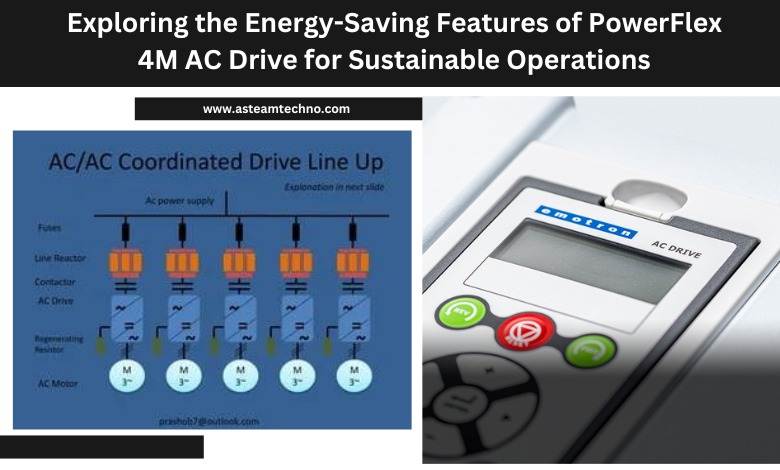A number of energy-saving features found in owerFlex 4M AC Drives can assist manufacturing facilities in lowering their energy usage and achieving sustainable operations. These qualities consist of.
1. Variable speed control:
Allen Bradley PowerFlex 4M AC Drives have variable speed control as a crucial energy-saving feature. The drives’ ability to precisely control motor speed enables the motor’s speed to be matched to the appropriate load, eliminating energy waste and increasing efficiency. Traditional fixed-speed motors operate at a given speed regardless of the load, which can lead to energy loss when the motor is not operating to its maximum potential.
The PowerFlex 4M AC Drive can vary the motor’s speed in real-time based on the necessary load thanks to variable speed regulation, which lowers energy consumption and boosts efficiency. For instance, the motor may need to run at various speeds in applications like HVAC systems to match the necessary airflow. The motor may run at the speed that will produce the required airflow with the help of a PowerFlex 4M AC Drive, resulting in less energy being wasted and greater efficiency.
In addition to extending the lifespan of motors and other components and lowering maintenance costs, variable speed control can also assist reduce wear and tear on those parts. Variable speed control is a crucial energy-saving feature that can assist manufacturing facilities in running sustainably and minimising their environmental impact.
2. Energy monitoring:
Another significant energy-saving feature of PowerFlex 4M AC Drives is energy monitoring. The drives have built-in energy monitoring features that let users keep tabs on energy usage and spot areas where it can be reduced. Utilising this information will improve motor performance and cut down on wasted energy.
Operators can discover locations where energy is being wasted and take action to reduce usage by monitoring energy use. For instance, they might spot places where equipment is left on needlessly or where motors are operating at full speed even when they are not required. Operators can alter motor performance, turn off equipment when it’s not in use, and make other changes to cut energy use with the help of this information.
Energy monitoring can also be used to find opportunities for energy efficiency improvements, such switching to more energy-efficient motors or other equipment. Operators can evaluate the impact of changes and make sure they are producing the anticipated energy savings by tracking energy use before and after upgrades.
3. Sleep mode:
Manufacturing plants can lower their energy usage by using PowerFlex 4M AC Drives’ sleep mode, which is another energy-saving feature. The drive can cut its energy usage by up to 98% by going into sleep mode while the motor is not in use.
In order to keep the motor in its position and use less energy, the drive lowers the voltage and frequency supplied to it. When the motor is required once again, the drive immediately increases the voltage and frequency to put it back in operation. This enables energy conservation while also making the motor ready for usage.
In situations where motors are not in use for extended periods of time, such as overnight or during breaks, sleep mode is especially helpful. Manufacturing firms can drastically lower their overall energy consumption and operational expenses by using less energy during these times. Additionally, by lessening wear and tear during times of inactivity, sleep mode can help extend the lifespan of motors.
Read: Rockwell Automation 22F-A1P6N103 PowerFlex 4M AC Drive
4. Regenerative braking:
Another energy-saving feature of PowerFlex 4M AC Drives that might assist manufacturing companies in lowering their energy usage is regenerative braking. The drive can capture and transform the kinetic energy that would often be lost as heat as a motor decelerates into electrical energy.
Regenerative braking minimises energy loss by allowing the electrical energy produced by the motor during deceleration to be recycled back into the power supply. This can increase system efficiency and help the system use less energy overall.
In situations where motors often decelerate, such conveyor systems, regenerative braking is very helpful. Manufacturing facilities can drastically lower their energy usage and operating expenses by capturing and utilising the energy produced during deceleration.
5. Soft start:
PowerFlex 4M AC Drives also have a soft start function that can assist manufacturing facilities use less energy. A motor can use a lot of current when it is started, which can cause an abrupt spike in energy usage. The power supply may be stressed by this surge, which will raise energy prices.
The motor may start gently and gradually with soft start because the drive progressively ramps up the voltage and frequency to the motor over time. By lowering the amount of current drawn during startup, this lowers the energy spike and increases efficiency.
In applications where motors are frequently started or when several motors are started at once, soft start is especially helpful. Manufacturing plants can lower their overall energy consumption and operational expenses by decreasing the rise in energy usage during start-up. Overall, manufacturing companies may cut their energy consumption, lower their operational expenses, and implement sustainable operations with the support of PowerFlex 4M AC Drives’ energy-saving capabilities. Plants can lessen their environmental impact and help to create a more sustainable future by including these traits.
